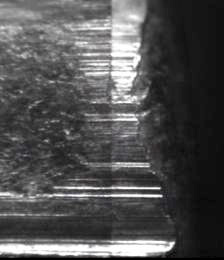- 01: Introduction
- 02: History
- 03: Propellants, Firearms, and Ammunition Development
- 04: Modern Firearms Manufacture
- 05: Small Arms Ammunition
- 06: Evidence Handling Procedures
- 07: Equipment and Instrumentation
- 08: Examination of Firearms
- 09: Cartridge and Shotshell Examination
- 10: Characterization and Evaluation of Fired Projectiles
- 11: Bullet Comparison and Identification
- 12: Gunshot Residue and Distance Determination
- 13: Toolmark Identification
- 14: Communicating Results
- Resources


Consecutive Matching Striae
Home > Cartridge and Shotshell Examination > Identification Process > Consecutive Matching Striae

Land impression striations from a 9mm Luger
caliber FMJ bullet fired from a Browning pistol
An evolving concept in striated toolmark comparisons is the developing study of consecutive matching striae (CMS) as a quantitative method of describing an observed pattern match.
CMS was initially proposed in a paper written by the late Al Biasotti and published in the Journal of Forensic Sciences in 1959 (“A Statistical Study of the Individual Characteristics of Fired Bullets”). In an extensive analysis of 720 known nonmatch comparisons of land and groove impressions in fired bullets, Biasotti found no instances in which the CMS exceeded four. Published research continued over the years by many individuals. In 1997, Biasotti and John Murdock jointly published their paper titled “Conservative Quantitative Criteria for Identification” using the CMS criteria.
Their criteria for identification were defined as:
“In three dimensional toolmarks when at least two different groups of at least three consecutive matching striae appear in the same relative position, or one group of six consecutive matching striae are in agreement in an evidence toolmark compared to a test toolmark. In two dimensional toolmarks when at least two groups of at least five consecutive matching striae appear in the same relative position, or one group of eight consecutive matching striae are in agreement in an evidence toolmark. For these criteria to apply, however, the possibility of sub-class characteristics must be ruled out.”
A number of significant studies have been carried out in an effort to further validate these conservative criteria.
Although not necessarily practiced by all firearms examiners, these criteria are of growing importance due to these factors:
- The expectations of more sophisticated jurors
- The need for more objective identification criteria
- The changing environment of the courtroom following Daubert v. Merrell Dow Pharmaceuticals
- The potential for increased credibility for examiners in the courtroom




